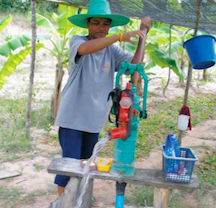Case-study /
Jasmine Rice in the Weeping Plain: Adapting Rice Farming to Climate Change in Northern Thailand


In 2007, farmers in Yasothorn Province, north-east Thailand, experienced the longest dry spell during a rainy season in decades. The dry spell, lasting from June until late August, reduced crop yields, lowering farmers’ income and reducing their food security.
Yasothorn, one of the 10 poorest provinces in the country, is part of the legendary ‘Weeping Plain’ named after its barren landscape. The Plain spans five provinces, covering more than 2.1 million rai (829,500 acres). The Plain’s dry conditions have made it suitable for growing the world-famous fragrant jasmine rice.
However, statistics from the Meteorological Department suggest that the dry spell that occurred in 2007 is not a one-off phenomenon, but part of a gradual trend that has developed in the past decade, due to rising temperatures and changes in rainfall patterns caused by climate change. Rainfall records for Yasothorn in the last decade show that the rains are arriving later and later each year, from a few days late to many weeks
Oxfam implemented an initial one-year pilot climate change adaptation project for organic rice, which ran from May 2008 to March 2009.
Coverage
May 2008 – March 2009, Province: Yasothorn, District: Mahachai Chana, Kut Chum, Lerng Nok Tha and Thai Chareon
Implementing organisations
Oxfam Thailand, Earth Net Foundation (ENF), SEA START
Key recommendations
- Participation of farmers in every stage of the project contributed to its success.
- Use of scientific data by farmers, government officials and scientists helped participants make informed decisions and was important in all steps of project implementation.
- Low interest loans for farmers enabled repayment without incurring further debt.
- Farmers’ new knowledge on climate change helped them apply their existing experience and skills to find solutions
